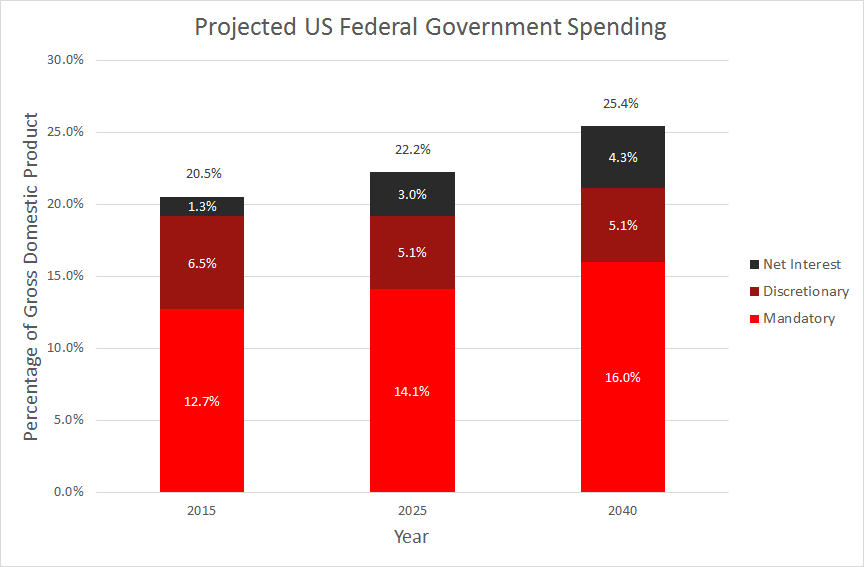
Physics is a business. To be more precise, making a living as a physicist is a business. Most physicists tend not to think of the profession in business terms, but that does not change the reality. One thing a business cannot do without is customers. For the majority of American physical scientists, the biggest customer, often the only customer, is the US federal government. Since the federal government “buys” (i.e. funds) most US research, the government’s future discretionary income has an enormous impact on physics business prospects down the road.
While it is always difficult to make detailed predictions about the future, US federal budget trends for the next few decades appear rather clear. Take the projections plotted below from the Congressional Budget Office (CBO) in their 2015 Long-Term Budget Outlook. The CBO quotes spending in terms of a percentage of the nation’s gross domestic product (GDP) because it removes the uncertainty in the value of the dollar over long periods of time due to variable rates of inflation. At first glance, the number do not look so bad since total federal spending is projected to rise from 20.5% of GDP today to over 25.4% in 2040. Looking at the breakdown, however, reveals that the entire increase goes to paying net interest on the increasing national debt and “mandatory” spending (i.e. entitlement programs such as Social Security, Medicare, etc.). The fraction of GDP going to “discretionary” spending, which includes funding for all federal science research, is actually set to decrease from current levels. There are also many other people competing for their piece of that reduced discretionary part of the budget pie, including the entire US defense establishment.
The above outlook is generally accepted as reality. Even the American Physical Society (APS) has stopped hoping for increased funding through traditional appropriations. Every January, the APS holds a leadership convocation and congressional visit day. I participated this year and was mildly surprised when they instructed us to thank the congress members and senators for their support of science, but not to be so naive as to ask for more funding. Instead, the APS is proposing alternative funding mechanisms outside normal discretionary appropriations. The proposal we circulated this year is for the creation of an independent American Research Investment Fund (ARIF) endowed with $100 billion taken from the proceeds of a tax holiday for repatriation of overseas corporate earnings. The fund would use the income from its endowment to invest in worthy basic research that is not supported by grants from the traditional agencies. The ARIF proposal generated some interest in the halls of government but is far from a done deal.
What is a physicist working in the US to do, given the path funding is on? It is hard to say definitely, but here are three reasonable strategies I have seen people succeed with:
- Become the Fittest – Competition gets though in environments with dwindling resources. So, if you do decide to play the traditional grant game through agencies like the DoD, DoE, and NSF, survival may require becoming a very good player. This means studying the fund process as much (if not more) than the science you are researching.
- Think Global – The current and near future US federal research budget may be flat or falling, but it is still the world’s largest in terms of total money available. Other countries, e.g. China, currently have smaller total budgets but are on increasing trajectories. This situation creates conditions ripe for international collaboration as the newcomers seek advice from the incumbent as they develop new projects. Clearly, this strategy is particularly attractive to those with existing overseas ties.
- Embrace Commerce – One way to stop relying on government funding is to reject it all together and find other customers. Of course, this approach has its own set of challenges, not least of which is that private sector customers are a lot more interested in near term applied research then the big questions of physics. If you can find an interesting niche in private industry, however, multiple customers can provide for a more stable business in the long run than just one.

